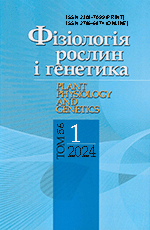Показано, що в листках рослин пшениці стійкого сорту Фаворитка розвиток ураження борошнистою росою супроводжувався значною інтенсифікацією активності супероксиддисмутази, зменшенням вмісту пероксиду водню та збільшенням утворення етилену. При цьому на другу добу ураження активність антиоксидантних ферментів, а також вміст пероксиду водню були значно вищими, ніж у листках сприйнятливого сорту Поліська 90. Це свідчить, що вже на початкових етапах ураження в листках пшениці стійкого сорту захисні системи активуються значно швидше та ефективніше, що в подальшому обмежує розвиток хвороби.
Ключові слова: Triticum aestivum L., супероксиддисмутаза, аскорбатпероксидаза, каталаза, пероксид водню, етилен, фенілаланінаміакліаза, Erysiphe graminis DC. f.sp. tritici Em. Marchal
Повний текст та додаткові матеріали
У вільному доступі: PDFЦитована література
1. Wheat flour: a problem and a solution (2009). Byul. kompaniyi Dyupon. Zeleni storinki, Cherven, pp. 6-7 [in Ukrainian].
2. Evtushenko, E.V., Saprykin, V.A., Galicyn, M.Yu. & Chekurov, V.M (2008). The effect of biologically active substances on the activity of phenylalanine ammonia-lyase and peroxidase in wheat leaves. Prikl. biohimiya i mikrobiologiya, 44 (1), pp. 123-128 [in Russian].
3. Zozulya, O. & Omelyanenko, O. (2010). Complex of diseases - complex fungicides. Agrobiznes sogodni, No. 6, pp. 16-17 [in Ukrainian].
4. Kovalishina, G.M., Muha, T.I., Murashko, L.A., Zayima, O.A. & Suddenkota,Yu.M. (2016). Characteristics of wheat varieties of winter for resistance to pathogens and pests. Selekciya ta nasinnictvo, 1 (30), pp. 50-56 [in Ukrainian].
5. Mocnij, I.I. & Blagodarova, O.M. (2004). Inheritance of disease resistance and morphological features in soft wheat hybrids with introgressive lines. Zb. nauk. prac SGI - NCNS, 6 (46), pp. 179-193 [in Ukrainian].
6. Omelyuta, V.P., Grigorovich, I.V. & Kaban, V. S. (1986). Accounting for pests and diseases of agricultural crops. Kyiv: Urozhaj, 296 p. [in Ukrainian].
7. Retman, S.V., Mihajlenko, S.V. & Shevchuk, O.V. (2008). Winter wheat: protection of crops from diseases. Karantin i zahist roslin, No. 11, pp. 1-4 [in Ukrainian].
8. Fedorenko, V.P. (2004). Integrated protection of agricultural crops in Ukraine. Materiali Mizhnar. nauk.-prakt. konf. "Integrovanij zahist roslin na pochatku HHI stolittya" (Kyiv, 1-5 listopada 2004). Kiyv, 2004, pp. 3-28 [in Ukrainian].
9. Chernyayeva, I.M., Luchna, I.S., Petrenkova, V.P. & Kochurov, Ya.V. (2012). New sources of resistance of winter wheat to diseases in the conditions of the north-eastern part of the Ukrainian forest-steppe. Genetichni resursi roslin, No. 10/11, pp. 132-140 [in Ukrainian].
10. Aebi, H. E. (1983). Catalase. In Methods in Enzymatic Analysis. New York: Acad. Press, pp. 273-286.
11. Bradford, M. (1976). Rapid and sensitive method for the quantitation of the microgram quantities of protein utilising: the principle of protein-dye binding. Anal. Biochem, 72, p. 248-254. https://doi.org/10.1016/0003-2697(76)90527-3
12. Giannopolitis, C.N. & Ries S.K. (1977). Superoxide dismutase. 1. Occurrence in higher plants. Plant Physiol., 59, No. 2, pp. 309-314. https://doi.org/10.1104/pp.59.2.309
13. Guzman, P. & Ecker, J. (1990). Exploiting the triple response of Arabidopsis to identify ethylene-related mutants. Plant Cell, 2, No. 2, pp. 513-523. https://doi.org/10.1105/tpc.2.6.513
14. Haouari, C.C., Nasraoui, A.H., Carrayol, E. & Gowia, H. (2013). Response of two wheat genotype to long-term salinity stress in relation to oxidative stress and osmolyte concentration. Cereal Res. Communic, 41, No. 3, pp. 388-399. https://doi.org/10.1556/CRC.2013.0020
15. Ivanisova, E., Ondrejovic, M., Chmelova, D. & Milar, T. (2014). Antioxidant activity and polyphenol content in milling fractions of purple wheat. Cereal Res. Communic, 42, No. 4, pp. 578-588. https://doi.org/10.1556/CRC.2014.0008
16. Latef, A.A. (2010). Changes of antioxidative enzymes in salinity tolerance among different wheat cultivars. Cereal Res. Communic, 38, No. 1, pp. 43-55. https://doi.org/10.1556/CRC.38.2010.1.5
17. Lu, Z.-X., Gaudet, D.A., Frick, M., Puchalski, B., Genswein, B. & Larocheet, A. (2005). Identification and characterization of genes differentially expressed in the resistance reaction in wheat infected with Tilletia tritici, the common bunt pathogen. J. Biochem. Mol. Biol., 38, pp. 420-431. https://doi.org/10.5483/BMBRep.2005.38.4.420
18. Meyer, N., Lind, V., Karlovsky, P., Zahn, M., Friedt, W. & Ordon, F. (2011). Development of a real-time PCR method for the identification of wheat genotypes carrying different eyespot resistance genes. Plant Breed., 130. pp. 16-24. https://doi.org/10.1111/j.1439-0523.2010.01808.x
19. Nakano, Y. & Asada, K. (1981). Hydrogen peroxidase is scavenged by ascorbate-specific peroxidase in spinach chloroplasts. Plant Cell Physiol., 22, No. 5, pp. 867-880.
20. Sagisaka, S. (1976). The occurrence of peroxide in a perennial plant, Populus gelrica. Plant Physiol., 57, No. 2, pp. 308-309. https://doi.org/10.1104/pp.57.2.308
21. Yang, J., Zhang, J., Liu, K., Wang, Z. & Liu, L. (2006). Abscisic acid and ethylene interact in wheat grains in response to soil drying during grain filling. New Phytol., 171, pp. 293-303. https://doi.org/10.1111/j.1469-8137.2006.01753.x
